The OCZ Vertex 2 Conspiracy: Lost Space, Lost Speed?
Several readers contacted me in the past two weeks, complaining about OCZ's recent adoption of 25 nm NAND and its effect on the capacity and performance of certain SSDs that they expected to be both larger and faster. I bought my own drives to compare.
Benchmark Results: PCMark Vantage Storage Test
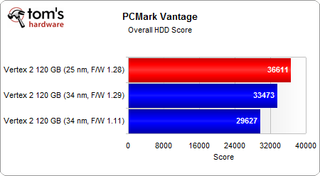
Overall, PCMark Vantage seems to actually like the 25 nm Vertex 2 drive better, going so far as to demonstrate a significant gain from upgrading OCZ's 1.11 firmware to 1.29 on the 34 nm-based SSD.
The tests that comprise PCMark’s HDD suite are much more difficult to interpret with regularity. Nevertheless, this is as close as we get to real-world workloads reflecting SSD performance.
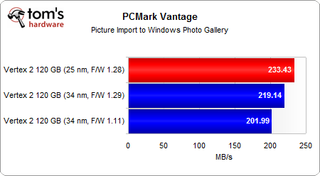
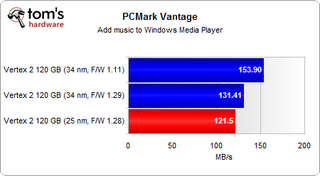
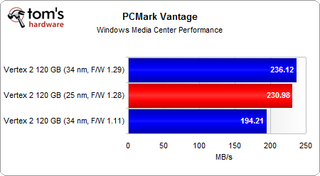
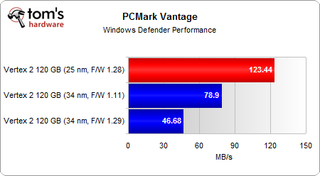

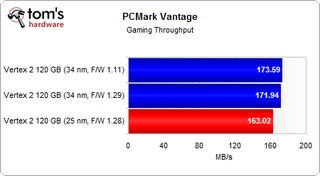
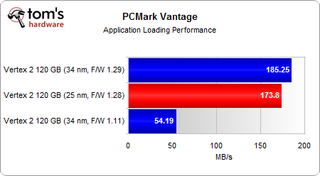
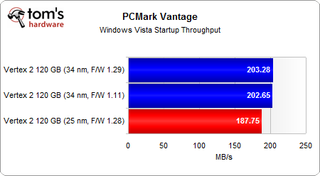
Our results seem to be all over the place, ranging from exceptionally positive in favor of the new Vertex 2 to slightly disappointing. None of the scores, however, are as bad in these trace-based workloads as the CystalDiskMark numbers would have otherwise suggested.
It looks like the worst finish is in the Vista Startup Throughput metric, where the new Vertex 2 loses just over 7% of its score with the 1.29 firmware installed in the older drive. On the other hand, the best finish is in PCMark Vantage’s Windows Defender test, where the new SSD achieves a 56% improvement over its predecessor. Interestingly, both benchmarks, which use 4 KB blocks, are dominated by reads (Windows Defender is 99% reads, while Vista start-up is 84% reads).
The bottom line here is that, almost assuredly, there are more situations where the old and new Vertex 2 drives trade blows in real-world desktop environments, rather than the new drive simply hemorrhaging performance, as you might think after considering the Iometer and CDM benchmarks.
Stay on the Cutting Edge
Join the experts who read Tom's Hardware for the inside track on enthusiast PC tech news — and have for over 25 years. We'll send breaking news and in-depth reviews of CPUs, GPUs, AI, maker hardware and more straight to your inbox.
Current page: Benchmark Results: PCMark Vantage Storage Test
Prev Page Benchmark Results: 4 KB and 512 KB Random Writes Next Page Conclusion: OCZ’s Sin-
Mushkin.com have a letter posted on the website that they will not be going to 25nm as the drives life cycle is less than half that of a 3*nm drive. Also the performance is not there.Reply
-
cangelini LeekayMushkin.com have a letter posted on the website that they will not be going to 25nm as the drives life cycle is less than half that of a 3*nm drive. Also the performance is not there.Reply
Depending on supply of 34 nm NAND, that's probably not a sustainable position to take. IMFT isn't going to decide to shift back to 34 nm.
At the risk of contradicting myself, Intel will be using 34 nm NAND on its next-gen 6 Gb/s Elmcrest drives. It's not like the flash isn't disappearing entirely, but the vendors making the switch seem to be motivated largely by cost-cutting reasons. -
Nicely done Mr. Angelini; however, I still think OCZ pulled a nasty car-salesman tactic on their newest 25 nm NAND SSD products, and as such will be looking elsewhere to purchase any future SSD. Blaming resellers or other sources for the SKU is an incompetent way of deflecting fault and has made them look even more silly.Reply
-
cangelini Thanks radiovan. Like I mentioned in the story, we'll have to see if companies like Corsair and Patriot are able to get their upcoming renamed SKUs onto Newegg, Tigerdirect, Zipzoom, etc.Reply -
1.29 Firmware....how nice... pity that ocz only documents 1.28 for the moment.Reply
And then again why not update the 25nm to 1.29 too?
But I guess consistency is not always wished when trying to demonstrate something -
nebun binoyskiOk, but when will we be able to buy ssd's that are $100 @ 1TB capacity?in about 10 years or so....that's a very big maybeReply -
yose3 binoyskiOk, but when will we be able to buy ssd's that are $100 @ 1TB capacity?Reply
when you throw a shoes to bush again meaby lol
-
Reynod It is all about profit.Reply
The real reason is that going to cheaper flash with a 3000 cycle life to reduce the total cost of production (and therefore increase profit) means ... increasing the amount of redundant memory to replace the flash that dies due to wear ... and that process means better error correction is required to achieve that ... therefore performance is effected.
Chris ... I got it into one sentence ... albeit a horrible one.
Nice article mate.
Most Popular


